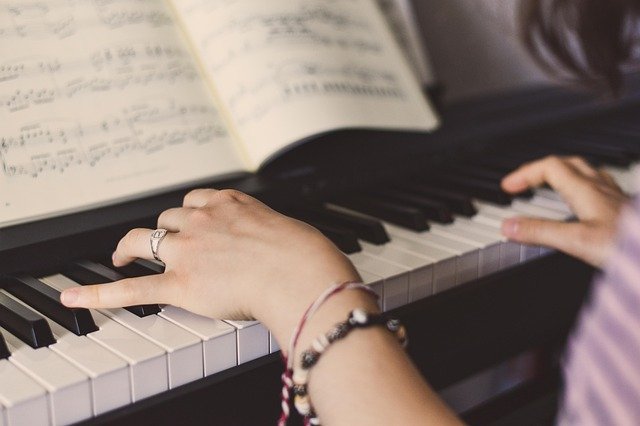Exploring the World of Pianos: Types and Features for Musicians at All Levels
Understanding piano types and features helps players choose an instrument that matches their needs and environment. Grand pianos deliver superior sound quality for performance, uprights are ideal for home use, and digital pianos offer versatility with recording capabilities, headphone use, and a variety of instrument voices for practice and composition.

Grand Pianos: The Ultimate Expression of Piano Craftsmanship
Grand pianos represent the pinnacle of piano design, characterized by their horizontal frame and distinctive wing shape. The most defining feature of grand pianos is their horizontal string arrangement and action mechanism, which allows for more precise control and faster key repetition than their upright counterparts. Concert grands, typically between 7’ to 9’ in length, offer the fullest dynamic range and tonal quality, making them ideal for concert halls and professional recordings. Smaller variations like baby grands (around 5’) and parlor grands (between 5’6” and 6’) provide similar mechanics in more compact forms suitable for home use while maintaining much of the tonal richness. The primary advantage of any grand piano is its responsive action mechanism, which gives pianists greater control over articulation and expression—essential for advanced repertoire.
Upright Pianos: Versatile Instruments for Everyday Musicians
Upright pianos, with their vertical string arrangement, were designed as space-saving alternatives to grand pianos. Professional upright pianos (48”-52” tall) offer rich tone and responsive touch that approach grand piano quality in a fraction of the space. Studio uprights (45”-48”) represent the middle ground of the category, balancing quality and affordability, making them popular choices for music schools and serious home practice. Console uprights (40”-44”) and spinet pianos (36”-40”) are the most compact options, ideal for apartments and smaller living spaces, though this comes with compromises in tonal depth and action responsiveness. Modern upright pianos have significantly improved in quality, with many featuring practice pedals, dual-tone options, and reinforced soundboards that enhance their versatility for both learners and accomplished pianists.
Digital Pianos: Modern Features for Contemporary Musicians
Digital pianos have revolutionized the instrument’s accessibility, offering realistic piano experiences without the maintenance requirements or spatial demands of acoustic instruments. Stage pianos focus on performance features with lightweight, portable designs and extensive sound banks beyond traditional piano tones. Home digital pianos prioritize realistic piano experience with weighted keys, built-in speakers, and furniture-style cabinets that blend into home décor. The most advanced models use sophisticated sampling technology, capturing nuances from world-class concert grands across different velocities and pedal positions. Features like headphone jacks, MIDI connectivity, recording capabilities, and built-in metronomes make digital pianos particularly appealing to students and composers. Many digital pianos now incorporate lesson functions with split keyboards, integrated sheet music displays, and interactive learning programs that accelerate the learning process.
Essential Piano Features for Beginner Musicians
For novice pianists, certain piano features significantly impact the learning experience. Weighted keys are perhaps the most crucial element, as they develop proper finger strength and technique that transfers to any piano. Full 88-key keyboards ensure beginners won’t outgrow their instrument as they advance to more complex compositions. Touch sensitivity, which allows volume variation based on how hard keys are pressed, helps develop dynamic control and expressivity from the start. Beginners benefit from instruments with clear tone production and good sustain capabilities, which help them hear the relationship between their technique and the resulting sound. Additional learning features like metronomes, recording functions, and split keyboard modes can accelerate progress by enabling self-assessment and practice flexibility. For young beginners, proper bench height adjustment and appropriate key resistance prevent physical strain and potential injuries during formative technique development.
Professional Piano Considerations: Advanced Features for Advanced Players
Professional pianists require instruments with exceptional responsiveness and expressive capability. The action mechanism—how the keys connect to the hammers—becomes critically important, with professionals often preferring the precision of grand piano actions with their escapement and repetition capabilities. Tonal palette and dynamic range allow for the subtle shadings necessary in advanced repertoire, from whisper-soft pianissimos to thundering fortissimos. For concert performers, projection capabilities matter greatly—how well the piano’s sound carries across large performance spaces without becoming harsh or thin. Stability in tuning and regulation, especially under challenging performance conditions like varying humidity and temperature, separates professional-grade instruments from lower tiers. The quality of materials used throughout the piano—from the soundboard’s resonant wood to the precision-engineered action parts—directly impacts the instrument’s longevity and consistency, crucial considerations for career musicians making substantial investments in their primary tool.
Specialized Pianos: Unique Instruments for Specific Musical Contexts
Beyond standard categories, several specialized piano types serve particular musical niches. Silent pianos combine acoustic mechanisms with digital functionality, allowing acoustic play that can be silenced and channeled through headphones—ideal for practice in noise-sensitive environments. Player pianos, modernized with sophisticated digital systems, can record and reproduce performances with remarkable accuracy, serving both educational and entertainment purposes. Historical reproductions of fortepianos and harpsichords offer authentic experiences for period performance practice. Hybrid instruments incorporating both acoustic elements and digital augmentation represent the cutting edge of piano evolution, offering unprecedented versatility for contemporary musicians working across multiple musical contexts. For specialized musical genres, pianos modified with prepared techniques, alternate tuning systems, or extended playing techniques open new sonic frontiers beyond traditional classical repertoire.
The piano’s enduring relevance across centuries speaks to its remarkable versatility and expressive potential. Understanding the various types and their distinctive features empowers musicians to select instruments that best serve their artistic vision, physical space, and budget considerations. Whether you’re taking your first steps on the keyboard or preparing for your next concert tour, the perfect piano awaits—one that will inspire your musical journey for years to come.




